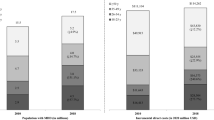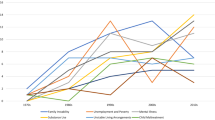Abstract
Purpose
To examine the prevalence of lifetime homelessness among veterans and use of Veterans Affairs (VA) homeless services, as well as their association with sociodemographic and clinical characteristics.
Methods
A nationally representative sample of 1533 US veterans was surveyed July–August 2015.
Results
Among all veterans, 8.5 % reported any lifetime homelessness in their adult life, but only 17.2 % of those reported using VA homeless services. Prevalence of homelessness and VA homeless service use did not significantly differ by gender. Being low income, aged 35–44, and having poor mental and physical health were each independently associated with lifetime homelessness. Veterans who were White or lived in rural areas were significantly less likely to have used VA homeless services.
Conclusions
Homelessness remains a substantial problem across different generations of veterans. The low reported uptake of VA homeless services suggests there are barriers to care in this population, especially for veterans who live in rural areas. Governmental resources dedicated to veteran homelessness should be supported, and obtaining accurate prevalence estimates are important to tracking progress over time.
Similar content being viewed by others
References
US Department of Housing and Urban Development (2013) The 2013 Annual Homeless Assessment Report (AHAR) to Congress: part 1, point-in-time estimates of homelessness. US Department of Housing and Urban Development, Washington
US Department of Housing and Urban Development, US Department of Veterans Affairs (2011) Veteran homelessness: a supplemental report to the 2010 annual homeless assessment report to Congress. US Department of Housing and Urban Development, Office of Community Planning and Development; US Department of Veterans Affairs, National Center on Homelessness Among Veterans, Washington, DC
Link BG, Susser E, Stueve A, Phelan J, Moore RE, Struening E (1994) Lifetime and five-year prevalence of homelessness in the United States. Am J Public Health 84:1907–1912
Link BG, Phelan JC, Bresnahan M, Stueve A, Moore R, Susser E (1995) Lifetime and five-year prevalence of homelessness in the United States: new evidence on an old debate. Am J Orthopsychiatry 65(3):347–354
Tompsett CJ, Toro PA, Guzicki M, Manrique M, Zatakia J (2006) Homelessness in the United States: assessing changes in prevalence and public opinion, 1993–2001. Am J Community Psychol 37(1–2):47–61
Greenberg GA, Rosenheck RA (2009) Correlates of past homelessness in the National Epidemiological Survey on Alcohol and Related Conditions. Adm Policy Ment Health Ment Health Serv Res 37(4):357–366
Tsai J, Mares AS, Rosenheck RA (2012) Do homeless veterans have the same needs and outcomes as non-veterans? Mil Med 177(1):27–31
Rosenheck RA, Koegel P (1993) Characteristics of veterans and nonveterans in three samples of homeless men. Hosp Community Psychiatry 44(9):858–863
Kulka RA, Schlenger WE, Fairbank JA, Hough RL, Jordan BK, Marmar CR, Weiss DS (1988) Contractual Report of Findings from the National Vietnam Veterans Readjustment Study. Vol II: tables of findings. Research Triangle Institute, Research Triangle Park, NC
Edens EL, Kasprow W, Tsai J, Rosenheck RA (2011) Association of substance use and VA service-connected disability benefits with risk of homelessness among veterans. Am J Addict 20(5):412–419
Fargo J, Metraux S, Byrne T, Munley E, Montgomery AE, Jones H, Sheldon G, Kane V, Culhane D (2012) Prevalence and risk of homelessness among US veterans. Prev Chronic Dis 9:E45
Metraux S, Clegg LX, Daigh JD, Culhane DP, Kane V (2013) Risk factors for becoming homeless among a cohort of veterans who served in the era of the Iraq and Afghanistan conflicts. Am J Public Health 103(Suppl 2):S255–S261
United States Department of Veterans Affairs (2009) Secretary Shinseki details plans to end homelessness for veterans
Petersen H (2013) $300 Million to help end veteran homelessness. Department of Veterans Affairs, Veterans Health Administration. http://www.va.gov/health/NewsFeatures/2013/August/300-Million-to-Help-End-Veteran-Homelessness.asp. Accessed 25 Aug 2015
Tsai J, Rosenheck RA (2015) Risk factors for homelessness among US veterans. Epidemiol Rev 37(1):177–195
Byrne T, Montgomery AE, Dichter ME (2013) Homelessness among female veterans: a systematic review of the literature. Women Health 53(6):572–596
Pietrzak RH, Cook JM (2013) Psychological resilience in older US veterans: results from the national health and resilience in veterans study. Depress Anxiety 30(5):432–443
US Census Bureau (2015) Current Population Survey. US Census Bureau. http://www.census.gov/cps/. Accessed 1 Sep 2015
US Interagency Council on Homelessness (2012) HUD: tips and resources on the new homeless definition. US Interagency Council on Homelessness. http://www.usich.gov/media_center/news/hud_tips_and_resources_on_the_new_homeless_definition. Accessed 13 June 2013
Weathers FW, Litz BT, Keane TM, Palmieri PA, Marx BP, Schnurr PP (2013) The PTSD Checklist for DSM-5 (PCL-5). US Department of Veterans Affairs, National Center for Posttraumatic Stress Disorder. http://www.ptsd.va.gov/professional/assessment/adult-sr/ptsd-checklist.asp. Accessed 8 Apr 2014
American Psychiatric Association (2013) Diagnostic and Statistical Manual of Mental Disorders, 5th edn. Am Psychiatr Pub, Arlington
Kroenke K, Spitzer RL, Williams JBW, Löwe B (2009) An ultra-brief screening scale for anxiety and depression: the PHQ-4. Psychosomatics 50(6):613–621
Bush K, Kivlahan DR, McDonnell MB (1998) The AUDIT alcohol consumption questions (AUDIT-C): an effective brief screening test for problem drinking: Ambulatory Care Quality Improvement Project (ACQUIP): Alcohol Use Disorders Identification Test. Arch Intern Med 158:1789–1795
Bradley KA, Williams EC, Achtmeyer CE, Volpp B, Collins BJ, Kivlahan DR (2006) Implementation of evidence-based alcohol screening in the veterans health administration. Am J Manag Care 12(10):597–606
QualityMetric (2014) SF-8 Health Survey. QualityMetric. http://www.qualitymetric.com/WhatWeDo/SFHealthSurveys/SF8HealthSurvey/tabid/187/Default.aspx. Accessed 8 Jan 2014
Ware JE, Kosinski M, Tuner-Bowker DM, Gandek B (2002) Version 2 of the SF-12 health survey. QualityMetric, Boston
Sherbourne CD, Stewart AL (1991) The MOS social support survey. Soc Sci Med 32(6):705–714
Amstadter AB, Begle AM, Cisler JM, Hernandez MA, Muzzy W, Acierno R (2010) Prevalence and correlates of poor self-rated health in the United States: the national elder mistreatment study. Am J Geriatr Psychiatry 18(7):615–623
McCallum Layton (2016) Confidence interval calculator for proportions. https://www.mccallum-layton.co.uk/tools/statistic-calculators/confidence-interval-for-proportions-calculator/. Accessed 1 Feb 2016
US Department of Veterans Affairs (2013) VA and HUD announce twenty-four percent reduction in veterans’ homelessness since 2010. US Department of Veterans Affairs. http://www.va.gov/opa/pressrel/pressrelease.cfm?id=2499. Accessed 6 Jul 2014
Susser E, Moore R, Link B (1993) Risk factors for homelessness. Am J Epidemiol 15(2):546–556
Caton CL, Shrout PE, Dominguez B, Eagle PF, Opler LA, Cournos F (1995) Risk factors for homelessness among women with schizophrenia. Am J Public Health 85(5):1153–1156
Folsom DP, Hawthorne W, Lindamer LA, Gilmer T, Bailey A, Golshan S, Garcia P, Unutzer J, Hough R, Jeste D (2005) Prevalence and risk factors for homelessness and utilization of mental health services among 10,340 patients with serious mental illness in a large public mental health system. Am J Psychiatry 162(2):370–376
Kasprow WJ, Rosenheck RA (2000) Mortality among homeless and nonhomeless mentally ill veterans. J Nerv Ment Dis 188(3):141–147
Schinka JA, Bossarte RM, Curtiss G, Lapcevic WA, Casey RJ (2016) Increased mortality in older homeless veterans. Psychiatr Serv 67(4):465–468
List of recessions in the United States. (n.d.) American Psychological Association. https://en.wikipedia.org/wiki/List_of_recessions_in_the_United_States. Accessed 23 Aug 2015
Tsai J, Kasprow W, Kane V, Rosenheck RA (2014) National comparison of literally homeless male and female VA service users: entry characteristics, clinical needs, and service patterns. Women’s Health Issues 24(1):e29–e35
Gamache G, Rosenheck RA, Tessler R (2000) Factors predicting choice of provider among homeless veterans with mental illness. Psychiatr Serv 51(8):1024–1028
Gundlapalli AV, Fargo JD, Metraux S, Carter ME, Samore MK, Kane V, Culhane DP (2015) Military misconduct and homelessness among US veterans separated from active duty, 2001–2012. JAMA 314(8):832–834
Agha Z, Lofgren RP, VanRuiswyk JV, Layde PM (2000) Are patients at Veterans Affairs medical centers sicker? A comparative analysis of health status and medical resource use. Arch Intern Med 160(21):3252–3257
Tsai J, Rosenheck RA (2014) Uninsured veterans who will need to obtain insurance coverage under the Affordable Care Act. Am J Public Health 104(3):e57–e62
Weeks WB, Wallace AE, West AN, Heady HR, Hawthorne K (2008) Research on rural veterans: an analysis of the literature. J Rural Health 24(4):337–344
Tsai J, Ramaswamy S, Bhatia SC, Rosenheck RA (2016) A comparison of homeless male veterans in metropolitan and micropolitan areas in Nebraska: a methodological caveat. Am J Community Psychol 56(3–4):357–367
Mohamed S (2013) Adaptation of intensive mental health intensive case management to rural communities in the Veterans Health Administration. Psychiatr Q 84(1):103–114
Morland LA, Greene CJ, Rosen CS, Foy D, Reilly P, Shore J, He Q, Frueh BC (2010) Telemedicine for anger management therapy in a rural population of combat veterans with posttraumatic stress disorder: a randomized noninferiority trial. J Clin Psychiatry 71(7):855–863
Bronson J, Carson A, Noonan M, Berzofsky M (2015) Veterans in Prison and Jail, 2011–12. US Department of Justice, Bureau of Justice Statistics
Nelson KM, Starkebaum GA, Reiber GE (2007) Veterans using and uninsured veterans not using Veterans Affairs (VA) health care. Public Health Rep 122(1):93–100
Author information
Authors and Affiliations
Corresponding author
Ethics declarations
Conflict of interest
None of the authors reports any conflicts of interest with this work.
Rights and permissions
About this article
Cite this article
Tsai, J., Link, B., Rosenheck, R.A. et al. Homelessness among a nationally representative sample of US veterans: prevalence, service utilization, and correlates. Soc Psychiatry Psychiatr Epidemiol 51, 907–916 (2016). https://doi.org/10.1007/s00127-016-1210-y
Received:
Accepted:
Published:
Issue Date:
DOI: https://doi.org/10.1007/s00127-016-1210-y




